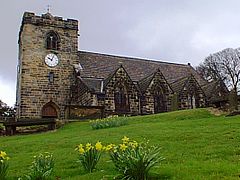Rawdon, West Yorkshire
| Rawdon | |
|---|---|
 St Peter's Church, Rawdon |
|
| Rawdon shown within West Yorkshire | |
| OS grid reference | SE421439 |
| Civil parish |
|
| Metropolitan borough | |
| Metropolitan county | |
| Region | |
| Country | England |
| Sovereign state | United Kingdom |
| Post town | LEEDS |
| Postcode district | LS19 |
| Dialling code | 0113 |
| Police | West Yorkshire |
| Fire | West Yorkshire |
| Ambulance | Yorkshire |
| EU Parliament | Yorkshire and the Humber |
| UK Parliament | |
Rawdon is a village and civil parish in the metropolitan borough of the City of Leeds, West Yorkshire, England. The appropriate City of Leeds Ward is Guiseley and Rawdon.
With William the Conqueror was a commander of archers named Paulyn who rendered such faithful and courageous service to the Norman cause that he was rewarded with lands, a portion of which was the manor on Rawden Hill. Granting manors to military leaders was more than a matter of largesse on William’s part. It was the medieval method of controlling newly conquered countries. For Paulyn, as for scores of other new lords of new manors, it meant a continuing obligation to the new ruler, but it also meant a near guarantee of prosperity by means of a new family seat and the control over fiefdom.
At the time of invasion, Paulyn, in common with his peers, had no true surname, or family name. Surnames were not yet necessary to distinguish one man from another. In fact, it seems that the first real use of the surname came about because of the Norman invaders’ need to know how much land they controlled and what the value of the land was. To determine this, a census, called the Domesday Survey, was taken of the 5,500-or-so land-holding knights and each was identified with a surname.
If Paulyn was still alive when the Domesday Survey was made, we assume that he received his surname – taken from the place-name Rawden (as it was spelled at that time). He is generally referred to as Paulyn de Rawden, meaning simply Paulyn of Rawden Hill Manor.
“Rawden” means in Old English “rough valley.” The manor, or tract of land, on the hill near the “rough valley” awarded to Paulyn was on the River Aire in the former Urban District of Aireborough in Yorkshire, England’s largest county. Rawdon, as it is spelled nowadays, is a quiet residential village with a fine view of Aire valley.
Rawdon Billing is a hill and well known local landmark that can be seen from a considerable distance.
Rawdon has a conservation area called Little London which lies to the westernmost area of Rawdon. Little London conservation area is unique in that the historic area covered by the designation straddles the boundary of the district and one of its neighbours, Bradford. This area was, until the local government reorganisation in 1974, part of a district called Aireborough which was divided between Leeds and Bradford during reorganisation. The portion of the conservation area lying in Leeds was designated in 1975 and was extended in 1988. The portion of the conservation area lying in Bradford was designated in 1977. The Bradford designation centres on Lane Head House, built for the steward of Esholt Hall Estate c. 1710–1720, with its associated cottages, and outbuildings and other mainly late 18th century development completing the designation. Little London is at the westernmost tip of the contiguous urbanised settlement of Rawdon which coalesces with Guiseley, the centre of which is approximately 1 mile (1.5 km) to the northeast of the conservation area. Greengates, and the edge of the Bradford urban area, is 1.2 miles (2 km) to the south of Little London. The area to the west of the conservation area is rural Green Belt, with Esholt village lying 1.2 miles (2 km) to the west of Little London in the Green Belt.
...
Wikipedia

